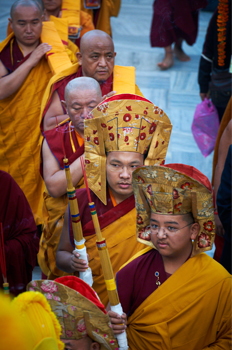For five days this year’s Monlam had been held at the Monlam Pavilion, two kilometers from Bodhgaya, so it felt strange on the sixth day to be in Bodhgaya, standing at the entrance to the Mahabodhi stupa grounds at five o’clock in the morning once more. Strange, but also very comfortable, like coming home. This ancient site radiates a pervasive feeling of sacredness, as if the broken stones themselves are a repository for two thousand years of devotion, hope, and trust in the way of the Buddha. Sitting under the bodhi tree, waiting for the Gyalwang Karmapa to arrive, people commented that they missed being at the stupa. However, for once, laypeople were able to sit where the novice monks and nuns would have been sitting, closer to the shrine, His Holiness and the bodhi tree, rather than crowded into the margins, hidden behind monuments, or perched precariously on the grass banks. Perhaps they had forgotten the advantages of the pavilion, where everyone is included and can have a clear view of what is happening, albeit from a distance.
Most of the ordained sangha were at the Monlam Pavilion where Khenpo Donyo was giving sojong and then leading a Medicine Buddha puja. Only the 103 fully ordained monks and nuns taking part in the procession had come to the stupa. For once the assembly was composed mainly of laypeople.
Apart from the garlands of marigolds, varying in colour from bright citrus yellow to a rich deep orange, strewn carelessly over the palisades, there were no decorations. The great offerings of torma, fruit and sweets were arrayed on the stage at the Monlam Pavilion.
H.E. Jamgon Kongtrul Rinpoche and H.E. Gyaltsap Rinpoche arrived shortly before 5.30am, followed, a few minutes later by the Gyalwang Karmapa and his entourage. Sitting on a low seat in front of the small shrine under the bodhi tree, His Holiness gave the Mahayana sojong vows, after the repetition of the refuge prayers in Sanskrit. . A momentary power failure meant that only those with torches could see to read the prayer,and then, the sky lightened gradually, and the golden capping of the Mahabodhi temple gleamed as it caught the first rays of light; the sounds of the sojong mantra were drowned by the bickering chatter of the mynah birds and the screech of parakeets.
His Holiness gave a short talk emphasizing the importance of Monlam and the good fortune of all those who had gathered there under the bodhi tree that morning. The crucial thing, he reminded us, was to make the commitment to work for the benefit of all sentient beings. We all had to work to make the Monlam meaningful, with pure motivations and the aspiration to benefit all sentient beings, that they might become enlightened, and enjoy peace, happiness and prosperity in all four corners of the world. We should also pray for the long life of great beings such as the Dalai Lama and the great masters of other traditions too, and remember all the neighbouring countries where there had been great suffering because of natural disasters or other troubles: India, Nepal, Tibet, Bhutan and Sikkim.
As His Holiness talked, his voice still wracked by a cold and cough, the sounds of the muezzin from the mosque close by the stupa, threatened to drown his.
In conclusion, His Holiness pointed out, all four pillars of the Buddhist sangha were at that moment present under the bodhi tree, gelong, gelongma, male lay practitioners and female lay practitioners. This made everything we did particularly powerful. Now it was up to us to develop compassion and loving kindness and transform our minds.
His Holiness turned round to face the shrine, and the chanting master led everyone in the Sanskrit prayers of refuge, generation of bodhichitta, and the heart sutra, finishing with the two four line verses which encapsulate Lord Buddha’s teachings, set to a traditional bhajan-style melody.
Do not do anything that is wrong.
Conduct yourself with utmost virtue.
Completely tame your mind.
This is the teaching of the Buddha.
By now it was light. The laypeople were sent off to line up on the left-hand side along the procession route to offer flowers and khatags but no incense. Meanwhile, thegelong milled around under the bodhi tree. Finally, when the laity were in place, thegelong and gelongma formed a line and filed through the open archway in the palisade which surrounds the main temple, collected their copy of the kangyur, and began the serbang (ritual procession). First they walked along the right side of the Mahabodhi stupa, then walked up the central steps to the large outer circuit.
At the head of the procession came one of the disciplinarians, bearing incense, followed by two monks playing gyalin and two monks blowing white conches. Next, surrounded by bodyguards and monks, came Gyaltsap Rinpoche, Jamgon Kongtrul Rinpoche, and the Gyalwang Karmapa, all three holding incense not texts. Behind them came the Kangyur- bearing gelong and gelongma, led by Ringu Trulku. Slowly the procession wound its way round the outer circuit, before finally returning down the steps and making a full circuit of the Mahabodhi stupa. At this point the Gyalwang Karmapa went into the temple to offer more golden silk robes, flowers and fruit to the Buddha.
The procession and crowds dispersed. Buses were waiting to take the monks and nuns back to Tergar Monastery, and for the laypeople there were tuk-tuks and cycle rickshaws eager for the first custom of the day.
When everyone arrived at Tergar Monastery there was chance for a quick breakfast before the next part of the Kangyur ceremony began in the Monlam Pavilion at 8.00am with a talk by the Gyalwang Karmapa on the history and vital importance of the Kangyur.



